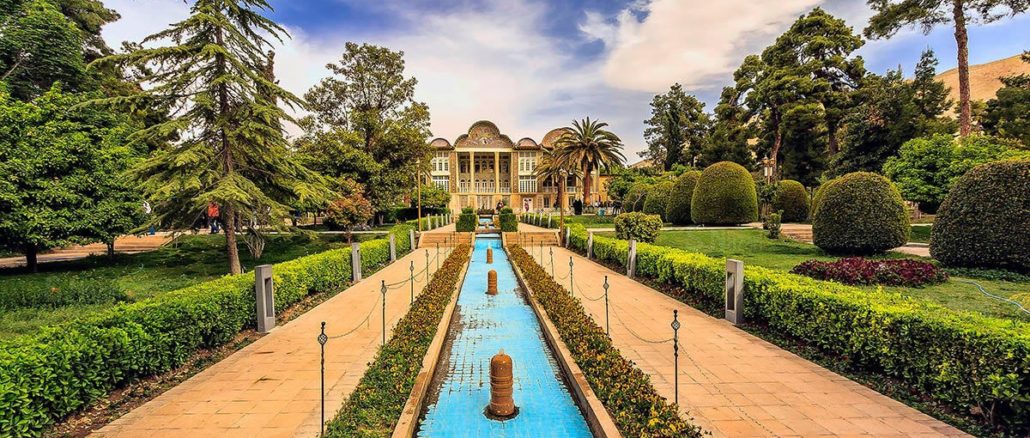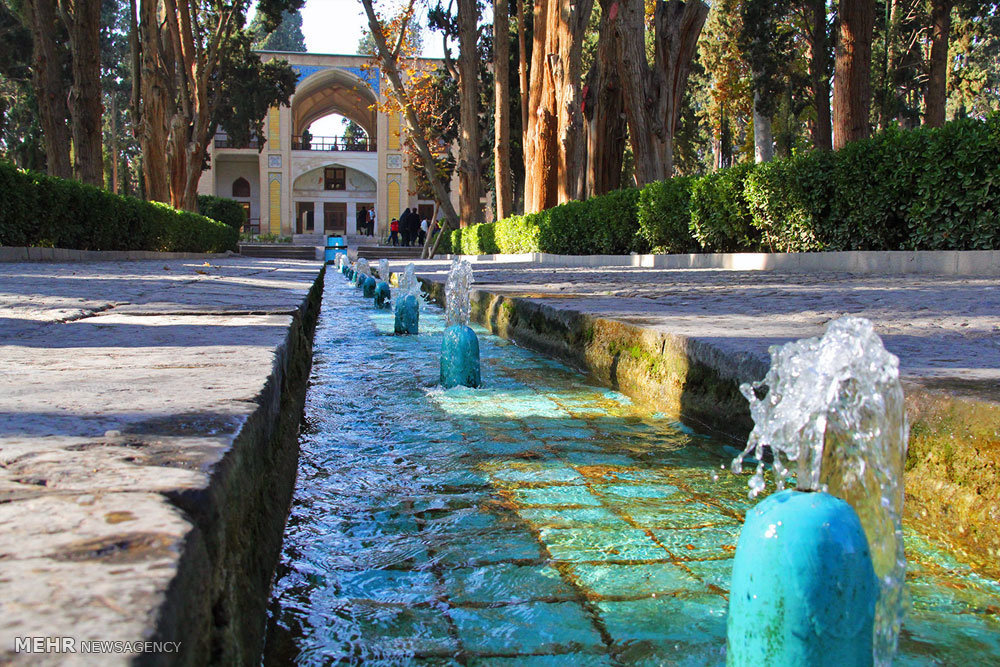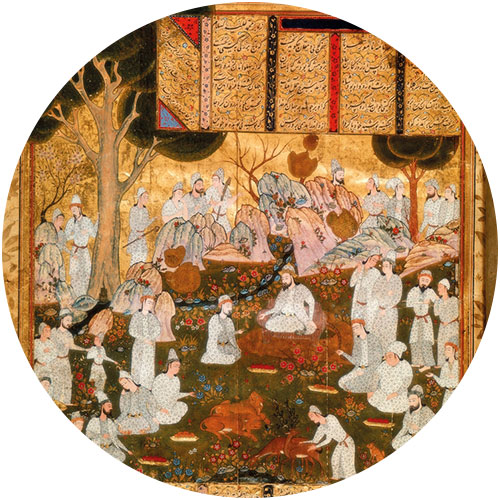
It is perhaps telling that the passion for such green spaces is particularly cherished in this region, home to some of the most inhospitable environments in the world. Ancient texts from the area, from the Epic of Gilgamesh to Zoroastrian scripts and the Code of Hammurabi, are lavish in references to gardens. In Persia, the love for gardens, probably influenced by earlier Mesopotamian civilisations, took root, flourished and, in turn, shaped architecture and arts in regions from India and Arabia to Spain.
To begin to understand a Persian garden, one must first return to its etymological origins. The idea of walls and enclosure is central to the creation of this slice of paradise. Outside the walls lies the unforgiving desert, rapacious and relentless in sapping life. Within the walls, there is life – water, flowers and sweet shade. The man-made oasis is a defiant refuge against death.
What makes the garden even more remarkable is the Persian insistence on apportioning precious water to it, in a land that sees sporadic rainfall and has few year-round rivers. Winters are harsh and summers intense. It is clearly a fine balancing act between nourishing the soul and life, and survival.

Fin Garden in Kashan features a trove of Persian decorative art. It is gradually being restored to its 16th century glory.
In such a landscape, every drop of water is precious. To bring water to the cities, early Persian civilisations constructed sprawling qanat systems, versions of which are still in use, to channel snowmelt from nearby mountains.
Relying on gravity, water is directed using open and underground channels to cities, farms, mills – and gardens. In these enclosed spaces, water flows into reflecting pools, fish ponds, tiled watercourses and fountains, cooling the air around and soothing the soul with its trickling sounds. This irrigation technique defines the layout of the classical Persian garden, called chahar bagh, or four gardens, where water channels and pathways divide the area into four symmetrical sections.
In every garden, water is celebrated. A walk down the pathways of the 16th century Chehel Sotoun, or Forty Columns, in Isfahan, illustrates this. A long reflecting pool runs the length of the garden, unifying the pavilion and palace at the end with the green surroundings. In the pool, one may see the reflection of the pavilion’s 20 columns, hence giving rise to the name.
With the life-giving water, one may then begin to plant. For the Persians, it is a careful curation of symbols and art as well – cypress trees as symbols of eternity and death, tulips for divinity and roses for love. Shrubs that thrive in different seasons are integrated to ensure year-round greenery.
The senses are not forgotten too – myrtle, lilac, oranges, lemons and jasmine scent the air. Pathways are laid with sandstone, bricks and tiles, so as to create texture and geometric patterns, often leading the eye to pavilions and pools. The Eram Garden in Shiraz, dating back to the Safavid era, illustrates the Persian love of plants, with its myrtle bushes, flowering shrubs, towering cypresses and cascades of water.
The other key to understanding the Persian garden is that it is a space meant for occupation. Unlike the English equivalent made for strolls, the Persian garden is a space to be. Those in homes are private refuges for meditation, reflection, family and life. Royal gardens are spaces for entertainment, socialising, debates, poetry recitals and such.
Tragically, in the last decades since the Iranian Revolution in 1979, however, Persia’s famed gardens, both royal and private, have largely fallen into neglect, and suffered damage from heedless development. It was only in recent years that the country took steps to halt the degradation of these sites. In 2011, nine surviving Persian gardens were finally inscribed in UNESCO World Heritage List.
Of these, the oldest, Fin Garden, continues to charm visitors and offers a respite from Kashan’s desert heat. Established in the 1500s, Fin suff ered neglect and damage from earthquakes and renovation. Restoration works in recent years, however, are gradually bringing the garden back to its former glory. Its pavilions and structures reveal intricate architectural and decorative elements of different Persian eras, from the Safavids to the Qajars.
While royal gardens often take the limelight, it is in smaller enclosed spaces such as traditional houses, teahouses and caravanserais that one truly lives in a garden. In the traditional houses of Kashan, the garden courtyard is a source of light, as well as cooled air to the surrounding rooms. Stained glass and arabesque windows add another layer of beauty to the rooms, using the light emanating from the courtyard.
In many ways, the paridaida is a metaphor for Iran today. Outside the walls, one sees the grim landscape. Within the walls, there is beauty and an ancient heritage cultivated by the love of life. These barriers between Iran and the world are gradually breaking down though, in large due to the inking of the nuclear agreement.
Foreign investments are making their way into the country, and the largely untapped tourism market is developing rapidly. The French Accord hotels group has launched its presence in Tehran, while the Spanish Melia Hotels is due to open its first luxury hotel in Iran by this year. The Iranian government has also ambitiously set a target to attract 20 million tourists a year by 2025, a far cry from its present figure of five million.
This emerging tourism market has not gone unnoticed nearer to home. In October last year, Thai Airways became the first airline to fly business from South-east Asia to Tehran. Kittiphong Sansomboon, Thai Airways regional director, acknowledges the rise of Iran as a new destination.
“We see potential in this route. Iran has a rich and ancient culture, and has a lot to offer to the adventurous. Increasingly, tourists are also looking for new and novel destinations. When you sit at a table with well-travelled friends, saying that you have just returned from Iran is a show-stopper in a way,” he says.
For those who would like to savoir the meditative calmness of a Persian garden, it is perhaps time to hit the road, before the tourists arrive.
THE PERSIAN GARDEN IN ART

World History Archive
“Pleasure, talk, a garden, and the spring time. That is all I need.” So penned 14th century Persian poet Hafez.
Muse for generations of Persian artists, the symbolism-laden garden is a rich wellspring offering metaphors and imagery for love, life, grief and death. With each season, the garden changes, and parallels the life cycle of man. Thus the garden in spring is often associated with joy and hope, and the autumn garden, with melancholy, nostalgia and death. Both a private retreat and a display of magnificence and royal wealth, the garden also came to symbolise the relationship of man with nature, soul and worldly possessions.
Persian poetry and prose are replete with references and uses of garden themes and motifs, as well as real and imagined gardens. Hafez waxed lyrical about the gardens of Shiraz while 10th century poet Ferdowsi dedicated sections of his epic poem, Shahnameh (above, depicted in a painting), to gardens and flowers. Roses, lilacs and lilies are compared to the mystical lover, the enclosed refuge is home to divine beauty, spirituality and meditation, and the withering of plants in autumn and winter signifies loss and grief.
But it is not in writing alone that the gardens weigh in. Classical Persian music took inspiration from this slice of paradise, and is often performed in gardens as well. Persian miniatures regularly feature garden settings for the unfolding of tales, such as a prince seated on a carpeted dais surrounded by flowering trees and gardeners. Famed Persian carpets often feature a stylised garden plan in their design. Even in the intricate tile work cladding mosques and palaces, you find the garden appearing, in stylised flowers and leaves.
TAN CHUI HUA, Photo Kashan
